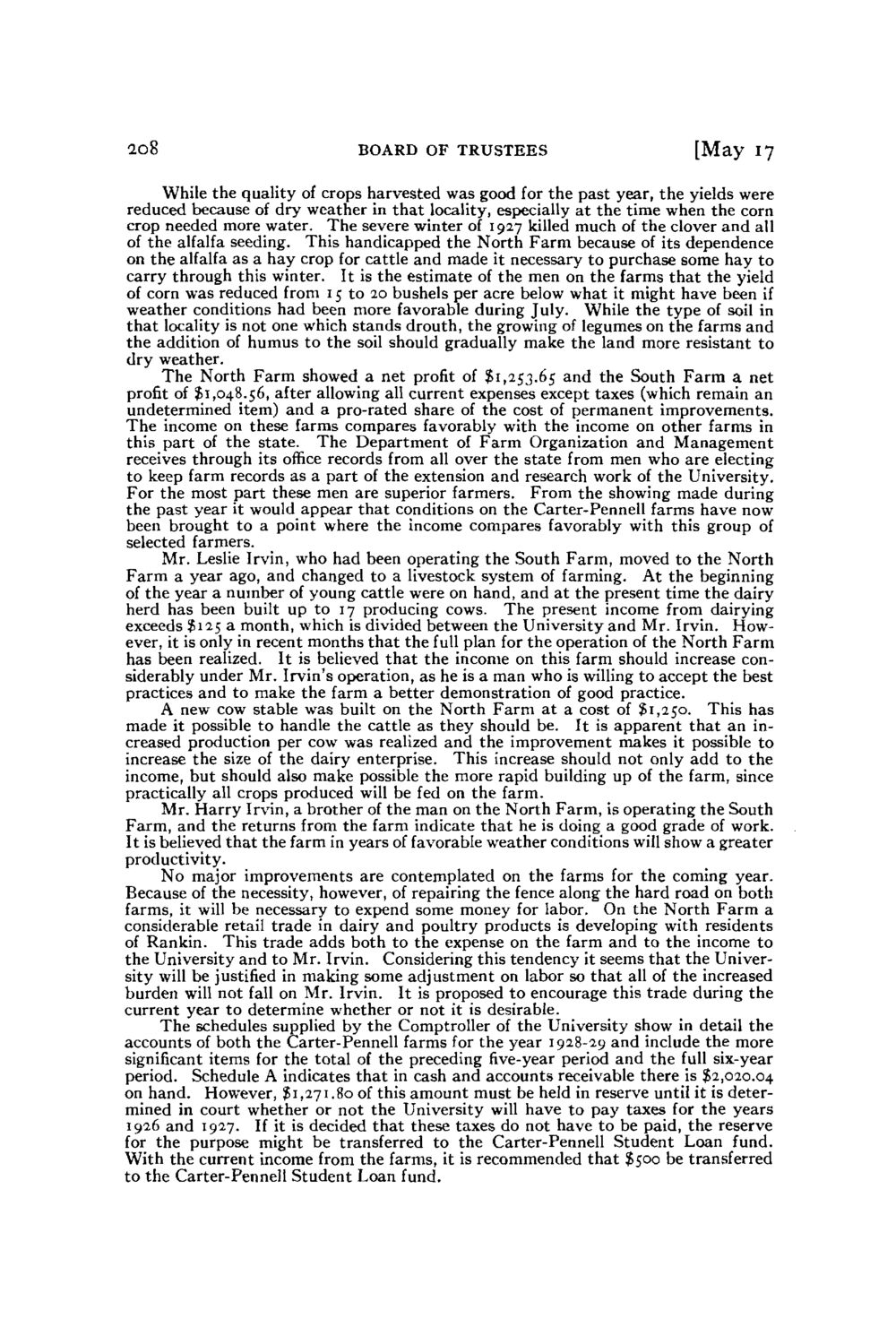| |
| |
Caption: Board of Trustees Minutes - 1930
This is a reduced-resolution page image for fast online browsing.

EXTRACTED TEXT FROM PAGE:
208 BOARD OF TRUSTEES [May 17 While the quality of crops harvested was good for the past year, the yields were reduced because of dry weather in that locality, especially at the time when the corn crop needed more water. The severe winter of 1927 killed much of the clover and all of the alfalfa seeding. This handicapped the North Farm because of its dependence on the alfalfa as a hay crop for cattle and made it necessary to purchase some hay to carry through this winter. It is the estimate of the m e n on the farms that the yield of corn was reduced from 15 to 20 bushels per acre below what it might have been if weather conditions had been more favorable during July. While the type of soil in that locality is not one which stands drouth, the growing of legumes on the farms and the addition of humus to the soil should gradually make the land more resistant to dry weather. The North Farm showed a net profit of $1,253.65 and the South Farm a net profit of $1,048.56, after allowing all current expenses except taxes (which remain an undetermined item) and a pro-rated share of the cost of permanent improvements. The income on these farms compares favorably with the income on other farms in this part of the state. The Department of Farm Organization and Management receives through its office records from all over the state from men w h o are electing to keep farm records as a part of the extension and research work of the University. For the most part these men are superior farmers. From the showing made during the past year it would appear that conditions on the Carter-Pennell farms have n o w been brought to a point where the income compares favorably with this group of selected farmers. M r . Leslie Irvin, w h o had been operating the South Farm, moved to the North Farm a year ago, and changed to a livestock system of farming. At the beginning of the year a number of young cattle were on hand, and at the present time the dairy herd has been built up to 17 producing cows. The present income from dairying exceeds $125 a month, which is divided between the University and M r . Irvin. H o w ever, it is only in recent months that the full plan for the operation of the North Farm has been realized. It is believed that the income on this farm should increase considerably under M r . Irvin's operation, as he is a m a n w h o is willing to accept the best practices and to make the farm a better demonstration of good practice. A new cow stable was built on the North Farm at a cost of $1,250. This has made it possible to handle the cattle as they should be. It is apparent that an increased production per cow was realized and the improvement makes it possible to increase the size of the dairy enterprise. This increase should not only add to the income, but should also make possible the more rapid building up of the farm, since practically all crops produced will be fed on the farm. Mr. Harry Irvin, a brother of the m a n on the North Farm, is operating the South Farm, and the returns from the farm indicate that he is doing a good grade of work. It is believed that the farm in years of favorable weather conditions will show a greater productivity. N o major improvements are contemplated on the farms for the coming year. Because of the necessity, however, of repairing the fence along the hard road on both farms, it will be necessary to expend some money for labor. O n the North Farm a considerable retail trade in dairy and poultry products is developing with residents of Rankin. This trade adds both to the expense on the farm and to the income to the University and to M r . Irvin. Considering this tendency it seems that the University will be justified in making some adjustment on labor so that all of the increased burden will not fall on M r . Irvin. It is proposed to encourage this trade during the current year to determine whether or not it is desirable. The schedules supplied by the Comptroller of the University show in detail the accounts of both the Carter-Pennell farms for the year 1928-29 and include the more significant items for the total of the precedingfive-yearperiod and the full six-year period. Schedule A indicates that in cash and accounts receivable there is $2,020.04 on hand. However, $1,271.80 of this amount must be held in reserve until it is deterto thethe current If it Student Loan fund. taxes do havehavethatbe paid, transferred With andpurposewhether be notthe farms, it the recommended payStudentforthe reserve for thein court might or transferred to is Carter-Pennell mined Carter-Pennell is decided the University will not to to taxes be the fund. 1926 1927. income from that these $500 Loan years
| |